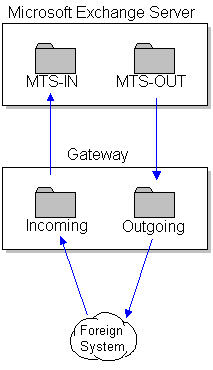
When a gateway is installed, the MTS-OUT and MTS-IN folders are automatically and permanently created. MTS-OUT holds messages coming into the gateway from Microsoft Exchange Server, while MTS-IN holds messages going out to Microsoft Exchange Server. Both folders store messages in Microsoft Exchange Server format.
Note For best performance, use the MTS-IN folder to create messages going into Microsoft Exchange Server, rather than creating the messages in another folder and transferring them to MTS-IN.
MTS-OUT and MTS-IN are automatically created. You can create additional folders for your gateway to use in managing the message transfer. The following figure shows an example of a message transfer design.

Sample message transfer design
This sample design includes the MTS-OUT and MTS-IN folders, both storing messages in Microsoft Exchange Server format, and the following additional folders storing messages in the foreign system format:
An incoming message folder is useful because it provides a place for the gateway to hold incoming messages if it cannot process them right away. Without an incoming message folder the gateway must process all incoming messages immediately, which can create performance or memory subsystem problems.
Incoming and outgoing message folders are also particularly useful if the gateway cannot remain connected to the foreign system all the time. For example, a UUCP-based (UNIX-to-UNIX Copy Protocol) gateway could cache outgoing messages that it has already translated in an outgoing message folder and then send them all in one batch when it can next connect to its UUCP host. Similarly, it would at that time receive a batch of incoming messages from the UUCP host that it could store in an incoming message folder for later sequential processing.
Additionally, gateways with flexible or dynamic routing to various remote addressing domains can use multiple outgoing message folders to hold outgoing messages bound for different domains. A gateway could also use multiple inbound message folders in this situation, although there is no particular benefit to doing so over storing all incoming messages in a single incoming message folder.